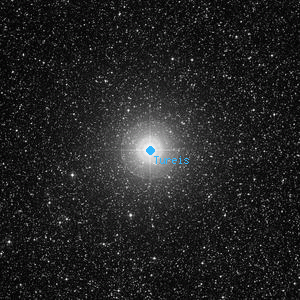Tureis

Overlaid DSS image of Tureis, 60' x 60' with north at top and west to the right
Aladin viewer for the region around Tureis
Rho Puppis, ρ Pup, 15 Pup
CD-23 6828, HD 67523, HR 3185, WDS J08075-2418A, SAO 175217, HIP 39757
CD-23 6828, HD 67523, HR 3185, WDS J08075-2418A, SAO 175217, HIP 39757
| Type | Star |
|---|---|
| Magnitude | 2.81 | Right Ascension | 8h 7' 32.6" (2000) |
| Declination | 24° 18' 15" S |
| Constellation | Puppis |
| Classification | F5IIkF2IImF5II |
Observing Notes
Captain William Henry Smyth
Oct 27, 1833 No. 6 The Crescent, Bedford, England (map)
150mm f/17.6 refractor by Tully 1827
A Greenwich star, with a distant companion, in the aplustre of the ship's poop; where an imaginary line from Rigel, passed close under Sirius, will reach it in the south-east region, by doubling the distance between those stars. A 3½, pale yellow; B 10, greyish; other small stars in the field. This star is called Tureïs, the scutulum or little shield, corresponding to ασπιδισκη of Ptolemy, A spacial movement is assigned it. to the following effect:P.... RA -0".2l Dec. +0".09Argo is one of the old 48 constellations, occupying a very large space in the Southern Hemisphere, but its lucida, Canopus, as well as most of its more important stars, is always hidden from us. There are sound reasons for assigning the highest antiquity to this grand asterism, though the etymologists are crowding on when they derive the English word canopy, or covering, from Canopus, as hath lately been imprinted: such sages would readily see our "son of a gun," in the Greek παις Γυνης (Dor.) "This constellation," says Sherburne, "sails by our meridian at midnight, in January, she being deified for saving deities;" but he takes no notice of a strange peculiarity in the good ship's sailing properties. In the apparent motion of the sidereal system, this constellation actually dips stern foremost, as Aratus remarked, but which the old scholiast, whoever he is, assures us, does not really set before the prow. Averso astro is very properly applied to it, as those who do not distinguish between a stem and a stern may satisfy themselves, on looking for the gubernaculum. There is, moreover, no stem to nobilis Argo, as Manilius designates it, the ship sharing the sectional system so remarkable in Pegasus and Taurus, which section was termed ημιτομος by the Greeks; and Aratus (54, Morel's ed. 1559) expressly says the ship was halved to the mast, ισον διχοωσα κατ αυτον. In the Theatrum Cometicum, 1667, by Lubienietzki, there is a large tabula Uraniscopica, on which Argo is represented as a goodly Argosie with three masts and a tier of ports; her courses and topsails are clean full with the wind aft, and yet she must be pulled back, and set stern foremost.
B.... -0".03 +0".08
[Hipparcos -0".08335 +0".04623]
Owing to the great extent of this constellation, it is subdivided into four departments,—the hull, the keel, the stern, and the sail,—Argo navis, carinâ, puppi, velis. Ptolemy assigned 45 stars to 'Αργω; but as a large portion could never be observed in our hemisphere, the number continued small till Bode made it amount to 540, by gathering all those observed by Halley, La Caille, and other southern observers. My friend Sir Thomas Brisbane, however, has registered no fewer than 1330 stars in Argo; and as the Via Lactea sweeps directly across it, there is yet a rich harvest for future astronomers.― A Cycle of Celestial Objects Vol II, The Bedford Catalogue, William Henry Smyth, 1844
Other Data Sources for Tureis
Nearby objects for Tureis
Credits...
Drawings, descriptions, and CCD photos are copyright Andrew Cooper unless otherwise noted, no usage without permission.
A complete list of credits and sources can be found on the about page
Tureis